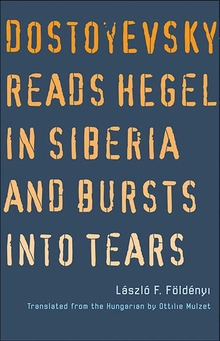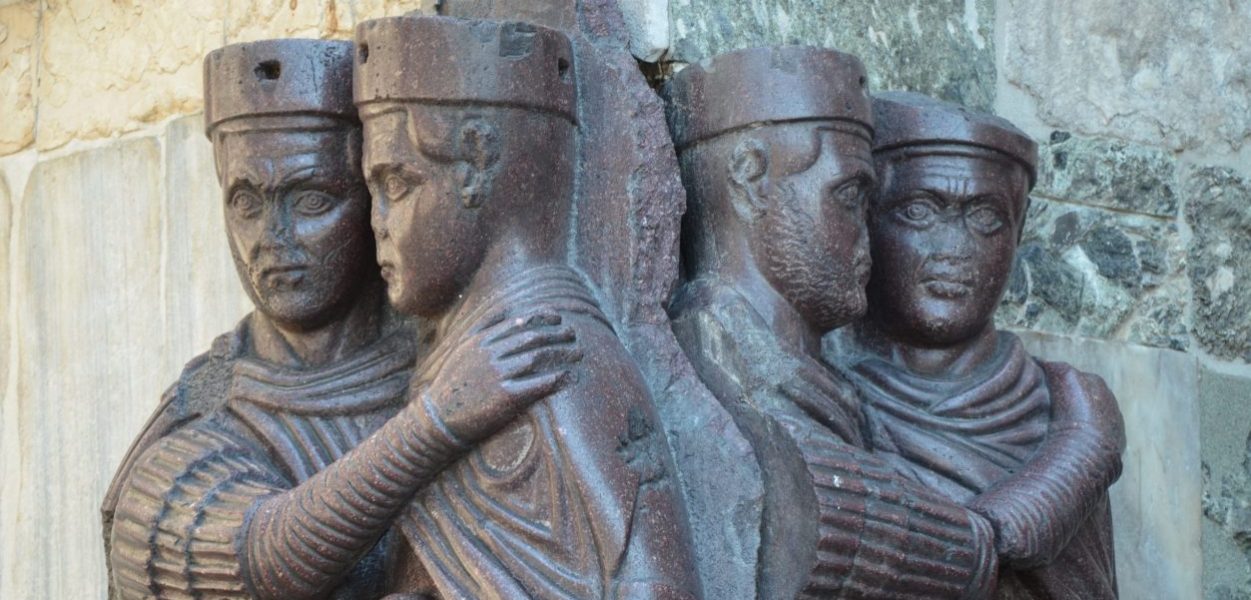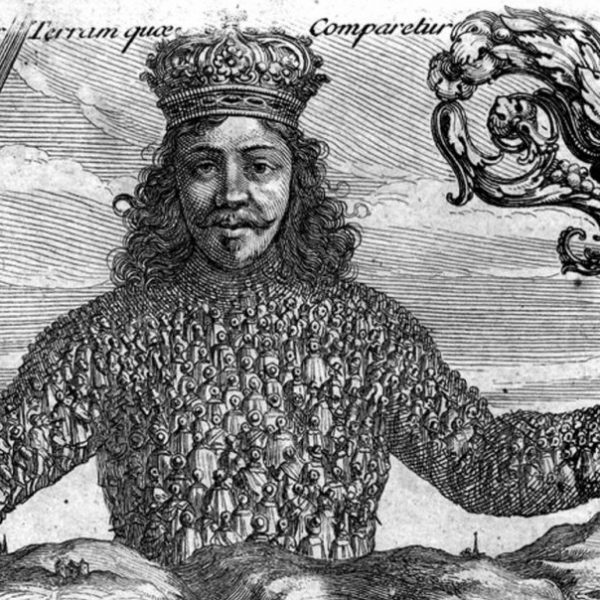Cosmic Order and Modernity
Laszlo F. Foldenyi—
In Venice, in an of the out-of-the-way corner of the Piazzetta located at the corner of the basilica of Saint Mark, there is a statuary group depicting the Four Tetrarchs. Carved out of the hardest granite, the sculpture, dating from the beginning of the fourth century, depicts Diocletian with three of his chosen co-sovereigns. They huddle together as if ready to brave the incipient end of the world. But we cannot exclude the possibility that they might be looking at us—we who are still living—from beyond the end of the world. It is as if they had been frozen into stone from the gaze of an invisible Medusa. If a living person happened to look at them, he or she would be drawn into a kind of unknown circuitry, and from that single gaze would become numb. For the viewer will have gazed upon the forms of human beings who are in possession of the secret of that which is inhuman.
What strikes one the most are the similarities among the four figures. Slightly smaller than human scale, they mutually embrace one another, their bodies clinging together, and they create the impression of being Siamese quadruplets emerged from a single ovum. Each draws our gaze; nonetheless, they are so uniform that no matter which one we begin to look at, we see the others as well. It does not matter with what small detail we commence our examination, we always perceive, involuntarily, the whole of the sculpture. Their shoes and their garments are uniform, their swords, crowns, and belts are uniform, the fabric on them is draped in a similar fashion, their foreheads are wrinkled in a similar manner, their gazes are uniformly careworn. There are four of them, and yet they appear to be one single living being. As if they were one body, grasping at each other, they melt into one another; they lose themselves within each other. And yet in no way are they destroyed; they simply continue being identical to their own selves. This is the secret of the strength that radiates from within them: the Four Tetrarchs truly become identical with themselves in surmounting their own selves, in the sacrifice of their own individuality. Each of them is who he is only through the others.
If we were, in imagination, to somehow tear off any one of the figures from the group of statuary, this magnetic force of their existence within each other and for each other would become dissipated. We would stand not before a figure now on his own but in front of a mere stump of a being. Not an individual, but a cripple. All the same, this imaginary amputation would not separate these four men from each other but would instead separate them from an invisible body. And with that we would be annihilating the secret of their unity. Because the statue of the Four Tetrarchs is not composed of four men—somehow brought together by circumstance—who will then at one point separate, each one following his own path. For that to be the case, each of them would have to be an individual personality, and the sculpture would resemble Rodin’s Burghers of Calais. In this case, however, we perceive no separate personalities or individuals. The secret of their metaphysical unity is carved into the stone. And this unity is not a question of determination or a decision. It is
Beyond thy lectures, learn’d professor,
Beyond thy telescope or spectroscope, observer keen—beyond all mathematics,
Beyond the doctor’ surgery, anatomy—beyond the chemist with his chemistry.
The oppressive similarity of the figures and their close physical proximity—unimaginable to anyone today, because such proximity would be unbearable—reveal to us that this unity is something both final and fateful, namely, it is also made up of a divine (or perhaps demonic) interdependence. Even if they wanted to, these figures could not become separate from each other. This is not because the Roman Empire would fall apart (a fact of which, looking at this group of statues, we are not necessarily aware), but because order itself would become damaged.
This order is something that goes beyond every human intention and conception; it cannot be planned: rather, it itself renders all kinds of plans possible. Just like the movement of the stars in the sky or the passage of time, it can never be susceptible to influence. This order is cosmic; to revolt against it would be as futile as revolting against the rhythms of birth and death. The utmost it offers us is the possibility of not noticing it, of stifling within ourselves the experience of this order. And if we decide to do so, we might even believe ourselves to be freer for a while. The illusion might even arise that at last we are the masters of our own self, autonomous beings with no accounts to settle with anyone or anything. Refuting cosmic order, we try to create our own—which for all intents and purposes means that we wish to impose our own will upon the world—and we are therefore obliged to match our individual strength against the strength of all the others coming forward with their own similar desires.
And who are these others? They are the ones who are present, even though I might prefer to be left alone. And the more of them there are, the harder it is to accept them.
This is the crowd of modernity, formed by those who are broken off from the cosmic order; more precisely, it is the multitude of individuals who have refuted this cosmic order. A crowd which is made up of all those who uniformly sense the universe as aimless, accidentally thrown together. The crowd wishes to be independent of everything that is beyond the human; the crowd rejects that metaphysical state toward which it could gravitate; and in order to somehow withstand the experience of the weightlessness of its own existence, it parrots ever more convulsively the slogans of freedom, considered to be irreconcilable with any sort of concession toward the concept of any higher order.
From Dostoyevsky Reads Hegel in Siberia and Bursts into Tears by Laszlo F. Foldenyi, translated by Ottilie Mulzet. Published by Yale University Press in 2020. Reproduced with permission.
László F. Földényi is professor and chair in the theory of art at the University of Theatre, Film, and Television, Budapest, and a member of the German Academy. He has written numerous award-winning books. Ottilie Mulzet is an award-winning translator and literary critic.
Further Reading:



























